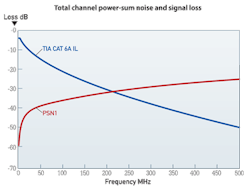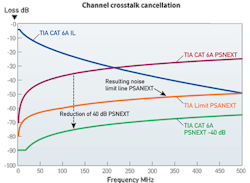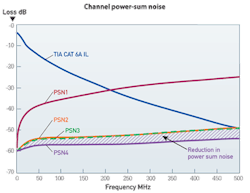For Category 6A channels, alien crosstalk matters most
From the May, 2014 Issue of Cabling Installation & Maintenance Magazine
The ability of network electronics to cancel internal noise has left alien crosstalk performance as the single most important factor in the ability to support 10GBase-T.
By Superior Essex
As 10GBase-T networking equipment has become more widely available and data center operators have deployed it as an efficient and economical means of achieving 10-Gbit/sec connectivity, the performance of Category 6A twisted-pair cabling systems has taken on increasing significance. The Category 6A specifications were developed specifically to enable compliant cabling systems to support 10GBase-T transmission. And though it has been a number of years since the Category 6A standard was finalized, the recent increase in 10GBase-T deployment has brought Category 6A back into the spotlight within our industry. And the "made-for-each-other" nature of 10GBase-T and Category 6A is a significant consideration when looking at the cabling system's performance, because of network electronics' noise-cancellation capabilities. This article will discuss the interrelationship between network electronics and cabling systems, focusing specifically on 10GBase-T and Category 6A. It also will provide detail on Category 6A systems' alien-crosstalk performance parameters, explaining why they are the most-critical characteristics in systems' ability to support 10GBase-T.
Electrical performance characteristics
In order to best understand the role and importance of different electrical-performance characteristics of a Category 6A cabling system, let's examine the six key characteristics in some detail.
Insertion loss (IL) is a single characteristic that is determined by multiple losses within a cabling system. The decrease in power of a signal as it travels from a transmission point to a receive point (signal loss) makes up part of the insertion loss. A signal's loss of power or energy (dielectric loss) also contributes to insertion loss. These losses combine with all attenuations and reflections of all components in a cabling channel to determine that channel's total insertion loss. The channel's insertion-loss performance can be viewed as a signal level, because it characterizes the strength of the signal that travels from transmission point to receive point. This performance characteristic frequently is referred to simply as "attenuation." In fact, several of the characteristics we will discuss next use the term "attenuation" to mean insertion loss.
Several other electrical-performance characteristics can be viewed as noise levels, because they characterize disturbances that can and do interfere with the signal traveling through the channel. Five parameters in particular make up total channel noise: return loss (RL); power-sum near-end crosstalk (PSNEXT); power-sum attenuation-to-crosstalk ratio, far end (PSACRF); power-sum alien near-end crosstalk (PSANEXT); and power-sum attenuation-to-alien-crosstalk ratio, far end (PSAACRF).
As you can see, several of these performance characteristics include attenuation-to-crosstalk ratios; as previously stated, the term attenuation often is used interchangeably with insertion loss. And insertion loss can be viewed as a measurement of signal level. So the signal-to-noise ratio (SNR) of a cabling channel is calculated by subtracting the total of the noise contributors (RL, PSNEXT, PSACRF, PSANEXT, PSAACRF) from the signal level (IR). A channel's total noise includes these noise contributors plus what is known as the "noise floor," "inherent noise," or "external in-band and out-of-band noise." This external noise also is sometimes described as externally induced background noise. Again, it contributes to a cabling channel's total noise.
Category 6A component, link and channel performance requirements, which are specified in ANSI/TIA-568-C.2, cover a frequency range (or bandwidth) up to and including 500 MHz. As such, the performance levels of the electrical characteristics discussed here, as well as others, are specified up to 500 MHz. When plotted on a graph, the performance-limit lines for Category 6A IL and power-sum total noise (PSN1) intersect between the 200- and 250-MHz points--less than halfway to the 500-MHz upper limit of Category 6A bandwidth. Theoretically, this intersection point is where the channel's noise is stronger than its signal, rendering the signal unreadable at the receive point. In that case, 10GBase-T would be inoperable at frequencies higher than approximately 200 MHz.
Improving SNR
That theoretical inoperability of 10GBase-T, however, does not translate to reality, because there are two fundamental ways to improve a channel's SNR to a level that permits successful transmission. The two improvement methods are: 1) using cabling components that prevent noise from exceeding the standard-defined limits and/or reduce the attenuation of the desired signal; and 2) using active components to eliminate noise that exists in the channel.
Several means exist to achieve method 1--improving cabling-component performance--but each of those means has one or more consequences. For example, an increased cable diameter can be the tradeoff for improvements in IL or internal crosstalk (achieved through conductor separation). The introduction of a shield can significantly improve alien-crosstalk performance, but such improvement is extremely challenging for the unshielded cables with which much of the industry is familiar and comfortable.
We turn then to method 2--using active components to eliminate channel noise. As Base-T Ethernet transmission speeds have progressed from 10 Mbits/sec (10Base-T) to today's 10 Gbits/sec (10GBase-T), the active components' role in eliminating channel noise has increased significantly. The term "active components" as used here refers to the chipsets built into transceivers and typically called PHYs. We will use the term PHY here as well.
As data rates have increased, copper PHYs have become increasingly more sophisticated, for the purpose of reducing channel noise so the signal strength remains stronger than the noise, thereby enabling successful transmission. 10GBase-T PHYs employ several such techniques, including coding algorithms, cancellation techniques, digital signal processing (DSP), and radio-frequency interference (RFI) cancellation. Without these noise-mitigation techniques in place within the PHY, the noise levels on a Category 6A channel would be prohibitively high.
Importantly, today's 10GBase-T PHYs employ cancellation technologies that are sufficient to effectively push RL, NEXT and FEXT well below the allowed AXT noise level. For example, it is typical for 10GBase-T PHYs to achieve a 40-dB improvement in power-sum near-end crosstalk (PSNEXT) through cancellation techniques. Such an accomplishment puts a channel's PSNEXT levels 10 dB below the noise contribution from alien crosstalk (AXT). Likewise, echo-cancellation techniques can improve a channel's RL performance by 55 dB or more, and the same digital-signal processing (DSP) techniques that improve PSNEXT can also improve PSFEXT by 20 dB or more. At these low levels achieved via the PHY's noise cancellation, internal near-end crosstalk becomes an insignificant contributor to total noise in the channel. This is why 10GBase-T PHYs and Category 6A cabling can be said to be "made for each other"--the PHY's noise-cancellation capabilities make it practical for manufacturers of Category 6A to economically produce systems that will support 10GBase-T.
In the typical case in which a PHY's noise-cancellation technologies reduce PSNEXT by 40 dB, PSFEXT by 20 dB and RL by 55 dB, additional improvements in PSNEXT or PSFEXT by as much as 4 dB are essentially ineffective in lowering the channel's total power-sum noise. So thinking back to the first method of improving a channel's SNR--improving cable-component performance--after a PHY's noise-cancellation capabilities are accounted for, modifications to components that improve internal noise levels do not provide a practical improvement in the total power-sum noise level.
On the other hand, improving a channel's alien-crosstalk (AXT) performance via improvements in cable-component performance, does directly translate to a lower total noise level for the channel. For example, reducing AXT by 6 dB has the effect of lowering the channel's total power-sum noise by 6 dB.
Alien crosstalk in focus
Alien crosstalk has taken "center stage" in many 10GBase-T/Category 6A discussions in part because of the unprecedented bandwidth in use. 10GBase-T uses five times the bandwidth that 1000Base-T uses (500 MHz vs. 100 MHz). Additionally, 10GBase-T's transmission scheme uses much more of its 500-MHz channel capacity than 1000Base-T does of its 100-MHz channel capacity. From a signaling perspective, 10GBase-T is significantly more complex than 1000Base-T.
And from a practical perspective, the placement and use of 10GBase-T-capable Category 6A cabling adds to the potential impact of alien crosstalk. A typical Category 6A system includes a significant volume of cables bundled together and traversing through ducts, raceways, trays, cabinets and racks. Alien crosstalk results from the coupling of one cable's transmitted signal onto another cable.
The specifications for Category 6A, in ANSI/TIA-568-C.2, include testing for alien crosstalk in a 6-around-1 design (6 "disturber" cables wrapped around 1 "victim" cable), using identical cables. However, in actual installations, different Category cables such as Category 5e or Category 6 often are installed adjacent to Category 6A cables. The impact of these adjacent, different-Category cables can be significant if the Category 6A cable is not sufficiently immune to alien crosstalk. Also, other Category 6A cables in a bundle, produced by different cable manufacturers, can introduce alien crosstalk that a victim cable is not sufficiently designed to protect against.
Adding to all of that is the reality that Category 6A cables deployed in the field are not perfectly balanced, but rather have asymmetries between tip and ring conductors. These asymmetries cause an unbalance that can increase crosstalk coupling between adjacent cables beyond the levels for which the cables are specified. Plus, unbalance within connecting hardware can generate noise that travels down a cable--creating additional alien noise on adjacent cables. The factors described here combine to potentially introduce additional alien noise, which a typical Category 6A system may not be designed to protect against.
Testing we have performed in our laboratory confirms these alien-crosstalk issues. Specifically, a standard-compliant Category 6A cable failed the power-sum alien-crosstalk (PSANEXT) requirement when it was surrounded by 6 Category 6 disturber cables. The Category 6A cable was not designed to protect against alien crosstalk generating from Category 6 or Category 5e cables. Cables that are designed to suppress all forms of alien crosstalk will perform better under such circumstances.
As mentioned earlier, improvements to a cabling system's internal-crosstalk performance do not lower the channel's total power-sum noise level. However, improvements to a cabling system's alien-crosstalk performance do lower the channel's total power-sum noise level--enabling such a cabling circuit to achieve better performance when placed in an environment that includes Category 5e and Category 6 cabling circuits, as well as Category 6A cabling circuits from other manufacturers.
Although the noise-cancellation capabilities of today's 10GBase-T PHYs are significant--in fact, much better than they were when 10GBase-T was introduced in 2006--these techniques are effective on internal-noise sources but not on external (alien) noise sources. As such, alien crosstalk is the limiting factor in Category 6A systems today. And the most effective way to add margin to a Category 6A channel's performance is to use a system that provides alien-crosstalk margin beyond the standard's requirements.
Editor's note: This article is derived from a white paper authored by Superior Essex, titled "Alien Crosstalk: The Limiting Noise Factor in Category 6A Channel Performance." The full paper, along with an overview and 20-minute on-demand webinar, are available on the Superior Essex website. http://www.ce.superioressex.com/resources/literature
This article was authored by the technical staff at Superior Essex (www.superioressex.com).
Archived CIM Issues


